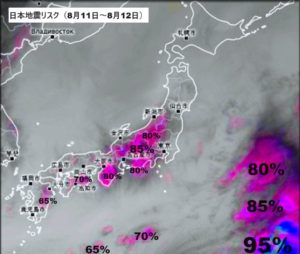On Thursday, a powerful earthquake with a magnitude of 7.1 struck off the southern coast of Japan, raising alarms but causing only minor injuries. The quake, centered off the eastern coast of Kyushu, the country’s southernmost main island, prompted the Japan Meteorological Agency (JMA) to issue tsunami advisories. While there were no reports of significant damage, nine people sustained injuries, most of which were minor.
The quake shook Nichinan city and surrounding areas in Miyazaki prefecture, with tremors felt across the island. Tsunami waves of up to 50 centimeters were detected along parts of Kyushu’s southern coast and the nearby island of Shikoku. Although initial concerns led to widespread tsunami warnings, these advisories were lifted within hours. The quake’s impact was also felt in transportation, with Kyushu’s “shinkansen” super-express trains temporarily halted for safety checks before resuming normal operations.
Seismologists Raise Concerns Over Nankai Trough Aftermath
In the wake of the earthquake, seismologists convened an emergency meeting to reassess the potential risks associated with the Nankai Trough, an undersea fault line known for triggering devastating earthquakes in the past. The JMA and experts from the University of Tokyo issued a revised assessment, indicating that the probability of a major earthquake along the Nankai Trough has increased.
Seismologist Naoshi Hirata highlighted that while the timing and exact location of a future quake cannot be predicted, there is now a 70-80% chance of a magnitude 8 or 9 earthquake occurring within the next 30 years. Despite these predictions, Hirata urged residents along the Nankai Trough to remain vigilant and review their earthquake preparedness, particularly over the next week when aftershocks are expected.
Japan’s Government Urges Caution Amid Quake-Related Disruptions
In the aftermath of the recent earthquake, Prime Minister Fumio Kishida quickly addressed the nation, highlighting the critical need for preparedness and the dissemination of accurate information. The Prime Minister reassured the public that the government’s crisis management team is fully engaged, with all measures being taken to enhance disaster readiness across the affected regions. Kishida emphasized that residents must adhere strictly to official guidance and avoid spreading misinformation that could escalate public anxiety.
The Fire and Disaster Management Agency has reported that most injuries were relatively minor, primarily resulting from falls or being struck by dislodged objects during the quake. In Kagoshima Prefecture, which borders the hardest-hit Miyazaki region, there were reports of structural damage, including collapsed concrete walls and a wooden house that sustained significant damage. Fortunately, no injuries were reported in Kagoshima. Meanwhile, Shigeki Aoki of the Japan Meteorological Agency (JMA) Seismology Department cautioned that aftershocks could continue for up to a week, underscoring the ongoing need for vigilance.
Nuclear Safety Reassured Despite Ongoing Seismic Activity
The earthquake has reignited concerns about the safety of Japan’s nuclear power facilities, an issue that has remained sensitive since the 2011 Fukushima disaster. In response, the Nuclear Regulation Authority quickly confirmed that all 12 nuclear reactors located on the islands of Kyushu and Shikoku, including the three currently operational reactors, were unaffected by the quake and continue to operate safely. This swift reassurance aims to alleviate public fears about the potential for another nuclear crisis in the wake of the earthquake.
Japan’s location along the Pacific “Ring of Fire” makes it one of the most seismically active countries in the world, with a long history of devastating earthquakes. Historical events, such as the deadly January 1 earthquake in the Noto region, which claimed over 240 lives, serve as a stark reminder of the persistent seismic threats facing the nation. Although Thursday’s earthquake was less severe, it underscores the ongoing risk and the necessity of continuous monitoring and preparedness efforts.
Preparedness and Public Cooperation: Key to Minimizing Quake Impact
In the face of ongoing seismic threats, both government and public cooperation are crucial to minimizing the impact of such natural disasters. Prime Minister Kishida’s appeal to the public to follow official directives and avoid the spread of misinformation highlights the critical role that accurate communication plays in managing public safety during emergencies. The government’s crisis management team remains on high alert, and local authorities have been mobilized to assess and address the immediate needs of affected communities.
Public awareness and preparedness are essential in earthquake-prone regions like Japan. The Japan Meteorological Agency’s warnings about potential aftershocks serve as a reminder of the importance of ongoing caution. Residents in the affected areas are encouraged to stay informed through official channels and to have emergency plans in place. As Japan continues to face the challenges posed by its geographic location, the collaboration between government authorities and the public will remain vital in mitigating the risks associated with future earthquakes.














